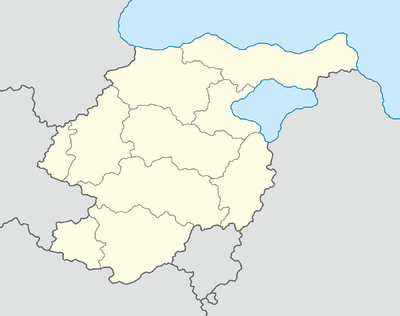Fortaine
Fortaine Republic | |
|---|---|
| Motto: "Alenda lux ubi orta libertas" "Let light be nourished where liberty has arisen" | |
| Anthem: "La Jaroisse " "The Jaroisian" | |
| Capital | Sant-Perende-sus-Moues |
| Official languages | Fortanian, Principean, Campassan |
| Demonym(s) | Fortaine Fortanian (archaic) |
| Government | Unitary parliamentary constitutional republic |
| Savié Noro | |
| Valentino de Valaïs | |
| Legislature | Parlamen |
| Population | |
• 2014 census | 11,304,212 |
| GDP (nominal) | 2018 estimate |
• Total | $579 billion |
• Per capita | $51,252 |
| Gini (2018) | medium |
| HDI (2018) | very high |
| Currency | Scudo (SC (SC)) |
| Date format | dd-mm-yy |
| Driving side | right |
| ISO 3166 code | FOR |
| Internet TLD | .for |
Fortaine (Principean pronunciation: [fɔʀtɛn]; Fortanian: Fortàni [fɔʀtan]; Campassan: Fòrtania [fɔrtɑniɑ]), officially the Fortaine Republic (Fortanian: Republico Fortàni, Principean: République Fortaine, Campassan: Repùblica Fòrtaniana) is an occidental country located in Auressia. Fortaine borders Vervillia to the north, Sabaria and Palia to the south, Draite to the west and the Galene sea, Lake Moîs and Barcia to the east. Its capital is Sant-Perende-sus-Moues and largest city is Rodovilo. Fortaine's X square kilometres of area are divided into ten Cantons of Fortaine which in turn consist of 1,054 municipalities.
Fortaine was first inhabited by the Astrenii people in the Iron Age. The conquest of the Astrenii by the Sabarine Empire in 273 BCE would lead to the creation of the Sabaro-Astrenii culture. Due to its position at the terminus of the Transalpine Vervillia-Calinisia route, Fortaine became one of the wealthiest Sabarine provinces. The fall of the empire resulted in the fracturing of political auhtority in Fortaine leading to the establishment of a myriad of small city states and fiefdoms. The Duchy of Fortania would rise to prominence in the area becoming a minor power. Under Bourtoumiéu I, the Kingdom of Fortania was declared in the 7th century. The kingdom would further expand in 1293 when the ascension of Claude I marked the creation of the Union between Fortania and Campassa. By the turn of the Early Modern Period, the country began to be called pars pro toto Fortaine due to the growth of centralized auhtority.
The early 19th century saw upheavalist ideas arrive in Fortaine. Although significant reform was passed, the country ultimately remained a monarchy throughout the upheavalist period. Following the First Great War, the monarchy was abolished, and the republic proclaimed in its stead. The nascent republic was divided politically between the Principean-minded Clemenites and the Fortanian-minded Lucians. In the Second Great War, the country was partitioned between Lanzist Palia and Vervillia in 1937. Liberation came in 1943, as the Coalition restored the republic. In the wake of the conclusion to the war, Fortaine began enacting consolidation policies. Financial support from Coalition powers helped the country's economy bounce back from the destruction of the war leading to a period of societal prosperity.
Fortaine is a developed country that has a high-income economy. It ranks highly in international listings ranking healthcare, education, freedom of the press and economic freedom. It is a member of the Occidental Confederacy.
Etymology
History
Politics
Government
Administrative divisions
Cantons
Fortaine consists of ten cantons (Fortanian: Cantoun). Each canton has an elected regional assembly (Fortanian: Assemblado regiounalo) to which elections are held every three years. Regional assemblies in Fortaine are devolved legislatures meaning their powers have been granted to them by the Fortaine Parlamen and are not enshrined in the constitution. The powers of each regional assembly vary significantly in Fortaine. For example the cantons Vitòriloudu, Val d'Orl, Monroujo and Troisepèye have varying degrees of control over their own budget and have their own language policies, while other cantons do not and follow the central government.
Cantons are based on broad cultural and historic regions of Fortaine.


